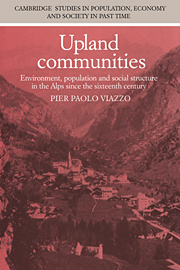 Upland Communities
Upland Communities Book contents
- Frontmatter
- Contents
- List of illustrations
- List of tables
- List of abbreviations
- Acknowledgements
- Introduction: anthropology, historical demography and the study of mountain societies
- 1 Environment, population and social structure: the Alpine village as an ecosystem
- 2 Open systems, open questions
- 3 Anthropologists in the Alps
- 4 The changing demography of Alpine communities
- 5 The traditional economy and its demise
- 6 The causes and consequences of Alpine emigration
- 7 The wealth from the earth: mining and immigration
- 8 Population, resources and homeostatic regulation
- 9 The domestic domain
- 10 Upland communities
- A summary of conclusions
- Bibliography
- Index
6 - The causes and consequences of Alpine emigration
Published online by Cambridge University Press: 13 October 2009
- Frontmatter
- Contents
- List of illustrations
- List of tables
- List of abbreviations
- Acknowledgements
- Introduction: anthropology, historical demography and the study of mountain societies
- 1 Environment, population and social structure: the Alpine village as an ecosystem
- 2 Open systems, open questions
- 3 Anthropologists in the Alps
- 4 The changing demography of Alpine communities
- 5 The traditional economy and its demise
- 6 The causes and consequences of Alpine emigration
- 7 The wealth from the earth: mining and immigration
- 8 Population, resources and homeostatic regulation
- 9 The domestic domain
- 10 Upland communities
- A summary of conclusions
- Bibliography
- Index
Summary
The medieval colonization of the high valleys
Current debates among ecological anthropologists clearly indicate that a shift from a synchronic to a long-term analysis of the relationships between environment and population is increasingly perceived as a crucial and urgent task. As Emilio Moran has recently remarked, a major limitation of ecological anthropology (and a rather paradoxical one, in view of the importance of the concept of ‘population’ in ecosystemic research) is that ‘ecological anthropological studies have only rarely explored the changing population variable over time’. The remedy, Moran has argued, can only be ‘an extension of the tools of ecological study to include also the tools of historical demography’.
That such an extension of method and theory can mark a very significant advance in ecological anthropology is, indeed, one of the main contentions of this book. But there is a fundamental problem which cannot be overlooked, namely that even in Europe demographic series usually go back for at most three or four centuries. In the case of the Alps, as we shall see, we are reasonably well informed about the period between 1700 and 1850, and for a few localities some data are available also for the sixteenth and seventeenth centuries. Moreover, useful information about the late Middle Ages can be gleaned from the historical literature, especially as far as settlement expansion is concerned. The penetration of the Alpine region by man, however, started some 100,000 years ago, and for this vast time span we can only rely on scanty and largely inadequate archaeological evidence.
- Type
- Chapter
- Information
- Upland CommunitiesEnvironment, Population and Social Structure in the Alps since the Sixteenth Century, pp. 121 - 152Publisher: Cambridge University PressPrint publication year: 1989


